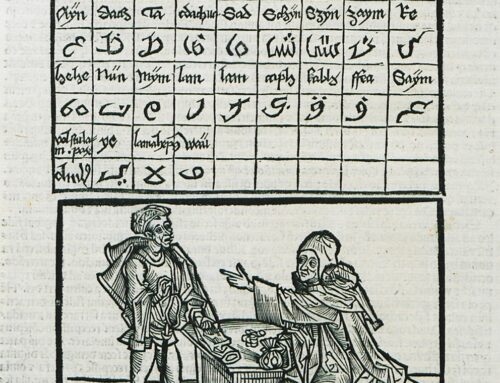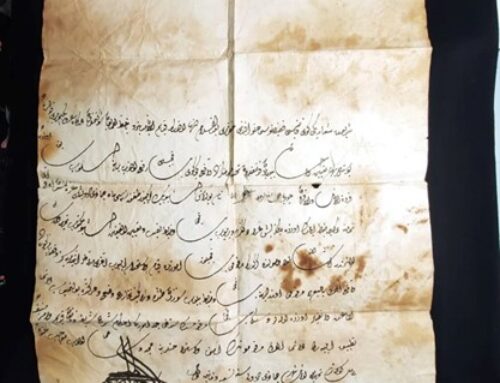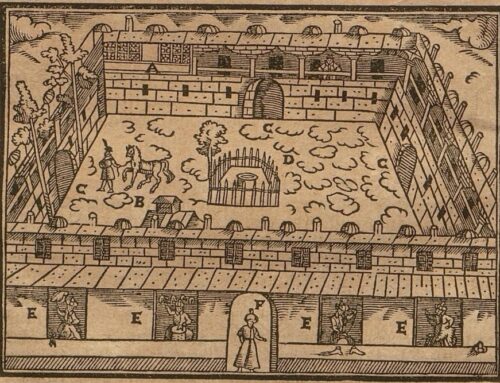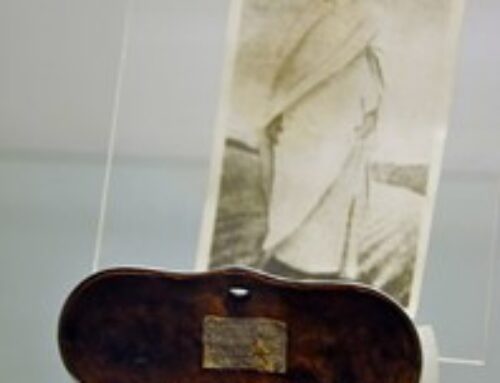At the turn of the 16th century, Ottaviano Petrucci was granted by the Venetian Signoria a twenty-year privilege to print and sell polyphonic music. This privilege offered him not only the opportunity to improve and develop new printing techniques for polyphonic music but also the monopoly of the production and trade of this repertoire in Venice.
The printing of chant liturgical music was already widespread during the 15th century, but, due to the complications linked to the process of printing, and to the uncertainty of the market, polyphonic music was a new and mostly unexplored field. Before Petrucci, printed vocal music was produced by using intaglio printmaking techniques, such as woodcuts, or a combination of printmaking and typographic techniques for the music and the text, respectively. Petrucci was the first to attempt the use of movable characters for both components; he was able to enhance the aesthetic appearance and the accessibility of the scores by improving the superimposition effects, and his techniques established the predominant mise-en-page used for the transmission of this repertoire during the Renaissance.
Between 1503 and 1514, the printer published in Venice and Fossombrone 11 books of frottole, a secular polyphonic repertoire that thrived in Italy from c. 1480 to 1530. The books of frottole form an anthology of nearly 700 musical pieces – for the compilation of which Petrucci undertook a remarkable work of collection, edition, and organisation of a complex and varied repertoire of a predominantly oral tradition. His elegant editions made accessible the repertoire to much wider and diverse audiences.
The intersection between this repertoire and its means of written transmission is significant for a reconstruction of the role that the newly born printing industry played in the distribution of this sort of Italian Renaissance secular music, as well as in the creation of new tastes and hence readerships for it.
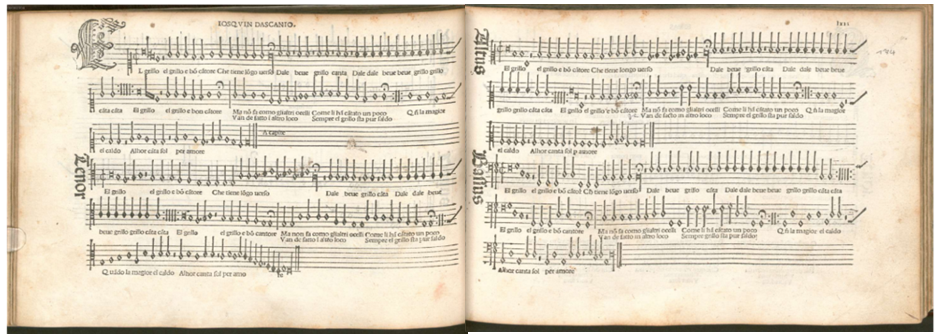 |
| Josquin Desprez, El grillo è buon cantore, Frottole Libro Tertio, Venezia 1505 (51v-52r), Digital image: Bayerische Staatsbibliothek München, Rar. 878-3, fol. 62v. |
By looking into the production methods of the books of frottole my research aims to solve problems concerning the identification of the actors behind the editorial work that underpinned the creation of those anthologies and the key role that Petrucci’s anthologies played in subverting the pre-existing oral tradition of the repertoire. Since Petrucci’s prints are the most conspicuous and abundant collection for the repertoire, looking into the entrepreneurial drives and the production systems that stand behind them is key to understanding how the anthologies were designed and assembled and the markets they targeted. My research, therefore, aims to carry out a systematic analysis of the internal press features of the volumes of frottole in order to look into the printing practices of Petrucci’s publishing house. Such analysis will contextualise the repertoire within the 16th-century musical printing market and will eventually become an important source of information for this particular aspect of the book trade, its readership, and the networks and the paths along which this secular repertoire was distributed during Renaissance Italy.
The production and design of musical texts, alongside their material infrastructure, constitute mostly unexplored and underrepresented subjects within the general discipline of bibliographical studies. A more detailed and rigorous approach to the materials, the formats, and the typographic designs of this sort of text will throw new light on the story and the significance of these printed artifacts. This will in turn provide a better understanding of their place not just in the history of music, but also within book and paper history. In the case of Petrucci’s production, identifying his purchasing policies, the different types of paper he acquired, as well as their provenance and physical features will help us understand the general economic and industrial patterns of his particular business, and establish the importance and the relevance that these books of frottole had within his publishing and commercial agendas.
Paper amounted to a large percentage of the production costs of an edition (c. 30% – 50%), which meant that stockpiling paper without a reasonable expectation of high sales had the potential to provoke a significant loss of capital and endanger the entire business. Identifying Petrucci’s paper purchasing policies, and his administration of this essential material during the different phases in the production of the books of frottole will give us new insights, and a more comprehensive understanding of his editions’ expected outputs as well as a measure of their success.
The identification of watermarks across and between different editions is also a valuable indicator of alterations and changes in the publication process. It contributes to tracing and establishing patterns that affect the different aspects involved in the stages that lead to the final product, from artistic and musical components to questions regarding the material format of the book. The consistency in the use of a particular type of paper with the same watermark, for instance, may suggest that a certain stock of paper was specifically bought for the production of a single edition. Stockpiling from a specific papermaker can be determined by mere economic convenience, the quality of that sort of material for the purposes required, or a combination of both. In general, phenomena such as volumes printed on different batches of paper, those with an unusually large number of different watermarks, or with paper of different or uneven quality, can become valuable evidence to establish the profitability and hence the popularity of a particular kind of musical genre, by providing a profile in the fluctuation of the markets, and detect the sort of audiences the final product was seeking. Furthermore, the internal order in which different papers are used across an edition and the comparison with previous or subsequent editions can give important clues on the chronology for the production of the volumes and the working patterns of the workshop.
My research proposes a detailed analysis of the paper and the watermarks in the different editions of the books of frottole and intends to cross-reference the results with information culled from the analysis of other typographical features such as the average number of types used, characteristics, and functions of special types (such as ligatures, colorations, signatures, tempo markers), differences in spelling, the use of proportional signs, signatures, and part names.
A critical comparison of the spelling conventions of both musical notation and texts within the same volume, and other indicators such as the different ways in which proportional signs are used can allow for the identification of different typesetters, as well as specific preferences and/or methods in the interpretation of the same manuscript source. This will not only reveal patterns in the division and distribution of labour within the workshop but also help determine the level of autonomy of the typesetters when it came to making decisions of this sort. When integrated with the textual, musical, and comparative analysis of concordant sources, this investigation will reveal the hierarchy in Petrucci’s workshop and the nature of his editorial policy, and also help establish whether there was a coherent approach for the whole corpus of frottole, or whether each book or perhaps a cluster of songs were edited in isolation.
Since books of frottole were a constant product throughout the entire printing career of Petrucci they are an efficient indicator of the evolution undergone by his editorial policies and his typographical patterns, which will allow us to formulate hypotheses on the relationship between the intellectual and material practices involved in the production of these printed artefacts. The analysis of the imprints will shed light on how the translation from manuscript to print altered the transmission of this sort of repertoire, by clarifying if some specific musical codifications, for instance, are exclusively the result of an editorial choice or the effect of a practical decision justified by the material and economic aspects of printing.
The study of the editorial work is key in understanding the type of public the anthologies were intended for. The typographic and material design of printed music is in fact determined by its eventual use for performance rather than for silent reading, as was the case for a majority of printed products. As a consequence, part of the copies that were heavily used, and perhaps heavily damaged, were discarded and recycled once the music genre was not performed anymore. It is not surprising that the extant copies of Petrucci’s anthologies of frottole all survived in bibliophiles’ collections. Of this significant production of books of frottole, only 23 copies survived, most of them in the libraries of these collectors, where the texts were hardly in frequent use by musicians. The extant sets belonged to rich families of collectors such as the Fugger family and Hernando Colón, whose copies do not carry the signs of usage (such as damage or manuscript annotations) that music scores would normally exhibit. This can indicate that Petrucci’s intent was to reach a market of performers, who intended to use the copies rather than possess them as a commodity. The nature of these performers can be partly researched through the editorial and technical choices that Petrucci (or his editor) made for his imprints. In short, looking into all these different aspects, starting from the materiality of the paper used for the editions, and also involving the typographic design of the final product, is an excellent starting point for a critical approach to Petrucci’s books and their intended readers.
Bibliography
Boorman, Stanley. ‘Did Petrucci’s Concern for Accuracy Include any Concern with Performance Issues?’ Zeitschrift: Basler Jahrbuch für historische Musikpraxis: eine Veröffentlichung der Schola Cantorum Basiliensis, Lehr- und Forschungsinstitut für Alte Musik an der Musik-Akademie der Stadt Basel 25 (2001): 23-37. Accessed 21 May 2022. doi.org/10.5169/seals-868987.
Boorman, Stanley. ‘Petrucci at Fossombrone: A study of Early Music Printing, with Special Reference to the Motetti de la Corona (1514-1519).’ PhD diss., University of London, 1976.
Boorman, Stanley. ‘Printed Music Books of the Italian Renaissance from the Point of View of Manuscript Study.’Revista de Musicología 16(5) (1993): 2587-2602.
Boorman, Stanley. ‘The 500th Anniversary of the First Music Printing: a History of Patronage and Taste in the Early Years.’Muzikološki Zbornik 37 (2001): 33-49.
Boorman, Stanley. Ottaviano Petrucci: Catalogue Raisonné. Oxford: Oxford University Press, 2005.
Raninen, Sanna. ‘Production and Reading of Printed Sources of Polyphony in the Early Sixteenth Century.’ PhD diss., University of Manchester, 2016.



